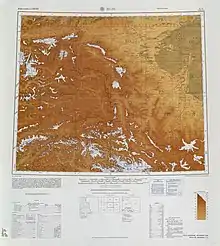Yeh-ch'eng
English

Map including YEH-CH'ENG (KARGHALIK) (AMS, 1966)
Etymology
From Mandarin 葉城/叶城 (Yèchéng), Wade–Giles romanization: Yeh⁴-chʻêng².
Proper noun
Yeh-ch'eng
- Alternative form of Yecheng (Kargilik)
- 1946, Military Information: Sinkiang Rebellions 1931-1937, page 10:
- By this time the T'ungkan forces had already advanced to Yeh-ch'eng on the south and to Pa-ch’u on the east, and had completed preparations for war.
- 1979, Kuo-ch'ing Tu, edited by William Schultz, Li Ho, Twayne Publishers, →ISBN, →LCCN, →OCLC, →OL, page 51:
- "My three sons are in Yeh-ch'eng to guard the frontier.
One son enclosed a letter to me:
The other two just died in battle.
Those who survive somehow live by their wits;
Thos who have died are finished forever.
- 1986, Monika Gronke, “The Arabic Yārkand Documents”, in Bulletin of the School of Oriental and African Studies, volume XLIX, number 3, School of Oriental and African Studies, →ISSN, →OCLC, page 491:
- Posgām (in Arabic letters written Būskām) is a large town to the southeast of Yārkand, situated on the trade route coming from Karġalik (today: Yeh-ch‘eng) at a distance of 21 miles from Karġalik. Posgām is the modern Tse-p‘u.
Translations
Yecheng — see Yecheng
This article is issued from Wiktionary. The text is licensed under Creative Commons - Attribution - Sharealike. Additional terms may apply for the media files.